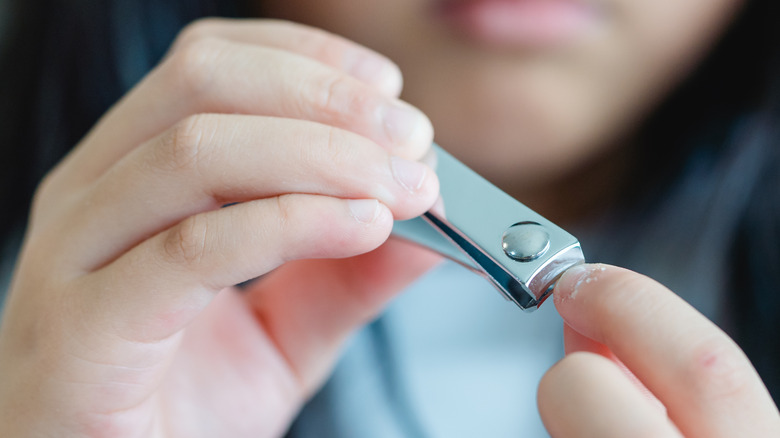The Real Reason Your Fingernails Grow Faster Than Your Toenails
How is it that we seem to need to trim our fingernails every time we turn around, while our toenails grow at a snail's pace? They're both our nails, so how is it that they're so different depending on whether they're on our hands or feet?
Made from skin cells, both our fingernails and toenails are essential for protection, functions such as scratching, as well as to enhance our sense of touch (via InformedHealth.org). The visible part of the nail that we paint is known as the "nail plate," which is made up of a protein called keratin. At the base of the nail lies a pocket of skin called the matrix, which is only partially visible to the eye in the form of a faint white crescent moon shape just above the cuticle. It's in the matrix where keratin is continuously produced and pushed forward into the nail plate, resulting in nail growth.
According to Healthline, our fingernails grow roughly 3.47 millimeters per month, with the nails on our dominant hand growing fastest. Growing far more slowly, our toenails average only 1.62 millimeters each month. What's the science behind this discrepancy, and are there outside factors that can influence the rate at which our nails grow?
Age and seasonal changes can influence the rate of nail growth
Jeffrey S. Dover, associate clinical professor of dermatology at the Yale School of Medicine, explained to the New York Times that while there are no hard and fast rules when it comes to nail growth, some factors can influence how fast or slowly they may grow. Bruce Robinson, clinical instructor of dermatology at Lenox Hill and Mount Sinai Hospitals, elaborated via the New York Times that nail growth slows as we get older. "[Fingernails] reach their peak growth in the second and third decades, with a slight decline thereafter," Robinson told the publication. Therefore, nail growth may be accelerated in younger individuals compared to older adults.
Robinson also cited seasonal changes as another source of influence over nail growth. It typically increases during the summer months but slows during the wintertime, with growth being observed more predominantly in males (via the New York Times).
Fingernails are more susceptible to trauma than toenails
According to Healthline, hormonal fluctuations can also play a role in our fingernail and toenail growth. Hormone increases experienced during puberty and pregnancy have been shown to boost nail growth during these periods. However, as hormones return to their baseline levels over time, nail growth decreases.
The number one factor that scientists believe contributes most significantly to the growth disparity between our fingernails and toenails is trauma (via Healthline). Areas of the body that are more exposed to the outside elements are more susceptible to injury. When you bite your nails or get your finger stuck in a door, this stimulates nail growth by signaling to the brain to send blood and nutrients to the injury to facilitate healing. Compared to our toenails, our fingernails are far more prone to trauma. Our toenails reap the benefits of being surrounded by the cushy padding of our socks and shoes all day long (via Science ABC).



